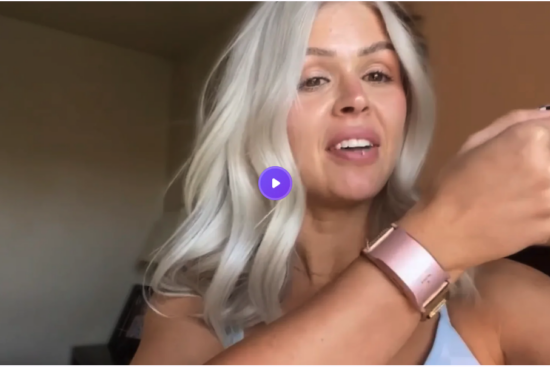
Introduction:
Are you tired of the endless cycle of nail biting? Do you want to achieve beautiful, healthy nails but find it difficult to break this habit? You’re not alone. Nail biting, also known as onychophagia, is a common habit that can be challenging to overcome.
Oftentimes, nail biters bite off more than they should chew and end up digging into the live skin and tissue underneath the nail, affecting the nail bed and the cuticle. This damaged skin is exposed to a greater likelihood of infection, especially because the mouth can be an excellent medium for transmitting bacteria and debris.
If that weren’t enough, nail biting has even been linked to certain mouth and dental issues because chronic nail biters can chip teeth and damage their gums.
However, with the right strategies and tools, such as the Pavlok wearable device, you can finally bid farewell to this unwanted habit. In this comprehensive guide, we’ll explore effective techniques, tips, and the power of Pavlok to help you stop biting your nails once and for all.
But to understand why the Pavlok method is so effective, you first must see why all the other advice out there isn’t.
Why Other Solutions Don’t Work
Today, when you find yourself with a socially embarrassing bad habit, it’s best to turn to Google. After all, you can find the best modern science society has to offer on the subject without having to admit to a single person you have a “weird” problem. There are entire businesses built on helping people quit their addictions, but the best we can do with nail biting is, frankly, shockingly embarrassing. Парень нашел новый источник. вдохновения, глядя на упругие сиськи красотки
Here’s an extensive list of all the strategies on the internet that claim to help you stop biting your nails:
- Keep your hands busy
- Keep your nails trimmed
- Maintain a healthy diet
- Fiddle with an object (good plug for fidget spinners)
- Do a hobby
- Use a “nibble inhibitor” solution on your nails, apply it several times a day, and carry a spare
- Consider covering your nails with band-aids, tape, or gloves
- Use fake nails and acrylics
- Take it easy, break the habit one nail at a time
- Maintain healthy nails
- Wear fake nails
- You can do anything you set your mind to!
- JUST STOP! (yes this was an actual suggestion)
- Rubber band yourself every time you catch yourself
- Fix underlying causes
- Enlist help
- Therapy
- Tell others to point it out
- Set reminders
- Wear “Chewelry,” i.e. necklaces and bracelets you can chew on instead
- Keep at it, don’t give up!
- Nail care
- Nail supplements
- Visualize success!
- Keep your nails short
- Keep a cuticle cutter in your purse
- Put on nail art that you wouldn’t want to ruin
As you can see, quitting nail biting is incredibly easy, all you have to do is pick one of the many useful strategies from this extensive list, and you should see results in no time.
In all seriousness, it’s not enough to only call these bad ideas out without examining why they don’t work, or if they do provide a temporary fix, why they don’t stick. So let’s explore the top six most popular suggestions and deconstruct why they don’t work with real psychological and behavioral change science.
Try Pavlok Today
Wake up the new you with our best-selling
Pavlok 3 and Shock Clock 3 wearables.
Shop Now
The Most Common Methods to Stop Nail Biting That Don’t Work
- Keep Your Nails Shorter
- Use a Bad Tasting Nail Polish to Prevent Biting
- Splurge on Manicures
- Keep Your Hands and Mouth Busy
- Cover Your Nails with Bandages, Adhesives, or Gloves
- Break The Habit Gradually, One Nail at a Time
1. Keep Your Nails Shorter
On the surface, this suggestion makes total sense, and it insidiously inspires someone to take quick action, clip their nails short, and think they’re cured forever. Until something happens, something they never expected, and their nails start to grow again.
You see, people don’t bite their nails when they’re short (duh) so having short nails will make you stop for a few days. But how do you keep them short? Now the theory begins to unravel. Much of the reason people bite their nails is that they have the opportunity to bite their nails. If they had a regular nail shortening and care routine, they probably wouldn’t bite in the first place.
So this method is a result of curing the habit, not a tactic to make the pattern stop. As you’ll see, a proper habit-forming or deforming routine gives considerable thought to the reward, and in this instance, a beneficial reward would be maintaining healthy nails and keeping them relatively short. But all of that happens after the urge to bite has come and gone.
In summary, most nail biters shorten their nails just fine with their mouth, keep their mouth away from them until they are long enough again, and go right back to biting.
2. Use a Bad Tasting Nail Polish to Stop Biting
Taste is a fickle thing. For example, do you like spicy food? If you do, you probably really like it. Moreover, you probably look to increase your spice tolerance when the opportunity arises. You might even remember a time when you didn’t like spicy food or food as spicy as you like now.
On the other hand, if you don’t like spicy food, you probably think all spicy food tastes horrible and you can’t understand why anyone would crave spicy food as much as your friends do.
The point is that taste is extremely relative and based on many psychological and physiological factors. Some studies even suggest our brains re-condition our taste buds to enjoy spice because of the nutrient density. So, it’s entirely possible that what you find repulsive today may not be so unpleasant over time.
Indeed, what we see happen is that exact pattern of desensitization. Commonly, people paint their nails with nasty polish all day, but can’t kick their habit. Much like the friend who chews Nicorette all day but still can’t stop smoking cigarettes, you can change one aspect of the behavior without truly conquering the habit.
As we’ll illustrate, what you’re doing, in this case, is only changing the routine part of the habit without doing the deep work to eliminate the triggers and reward the new behavior.
Try Pavlok Today
Wake up the new you with our best-selling
Pavlok 3 and Shock Clock 3 wearables.
Shop Now
3. Splurge on Manicures
This one feels like some manicure lobbyist invented it (c’mon, they exist!). It’s like we can’t fix any of our problems in America without someone suggesting that we just throw more money at it.
This one fails for many of the same reasons but hurts even more because now your bank account is crying louder than your nail beds and you’re feeling guilty every time you chomp down on those expensive bedazzled scratchers.
Look, manicures are lovely, but I won’t be fooled into thinking that just paying your way out of a problem will cure you.
4. Keep Your Hands and Mouth Busy
If Pavlok made a fidget spinner, this is where we’d link to it. As much fun as it is to believe we all have ADHD, fidgeting can’t be the cure for everything. The popularity of fidget cubes and fidget spinners has more to do with smart marketing than changed behavior and a happier, more focused society.
Certainly the most committed to change could find a way to have something in their pocket to play with at all times along with a fresh stick of gum on hand, but do you want to live like that? One empty pocket away from a relapse?
The minute you’re empty-handed you’ll likely return to your old ways. Precisely because you haven’t changed anything about them, you’ve just anxiously avoided dealing with them in perpetuity. It’s like the people who just push their debt further and further into the future accruing more and more along the way. Eventually, everything crashes to a standstill, and you’re back to square one.
5. Cover Your Nails with Bandages, Adhesives, or Gloves
One of the biggest reasons people wish to quit their nail-biting habit is because it causes social awkwardness, as we mentioned at the beginning of the article.
Wearing gloves around all day, especially if you live somewhere warm, will cause even more interpersonal angst. And even if you get away with looking like a deranged serial killer most of the day, it just doesn’t seem very practical. Let’s see if an office worker gets any emails written with garden gloves on all day. 😉
Until Kanye West makes wearing bandages around every fingertip the next fashion trend, let’s not seriously consider this as even a remote solution. And again, as soon as the gloves come off you’re back to biting.
6. Break the Habit Gradually, One Nail at a Time
Out of all the common suggestions, this is the one that stands out from the rest because it’s the only one that includes an iota of habit science.
Acclaimed masters of habit like Charles Duhigg and Leo Babauta recommend breaking up habits into bite-sized chunks you can conquer over time. Although it’s a slippery slope towards chewing every finger.
For some habits, like working out, breaking up your routine and starting with one push-up a day makes sense, but for nail biting, one nail usually means all nails.
At the end of the day, the mental resources required to resist biting one finger at a time are the same needed to withstand biting all your fingers. So why not recruit those resources for the right project and tackle the habit with science?
How Pavlok and the Power of Habit Change Can Help You Stop Biting Your Nails for Good
It’s widely considered (and popularized by Charles Duhigg in his book The Power of Habit) in the study of behavior change that a habit is composed of three fundamental parts: the cue or trigger, the routine, and the reward. To change a habit, you must tackle all three areas.
This again, is why many of the common suggestions don’t work. They target one aspect, two at best, and they don’t holistically solve the problem. However, more capable students could mix and match different suggestions with a strategic study of their triggers to make headway.
But if you’re looking to stop biting your nails for good, the entire solution comes in the form of Pavlok.
How Pavlok and the Power of Habit Change Can Help You Stop Biting Your Nails for Good
It’s widely considered (and popularized by Charles Duhigg in his book The Power of Habit) in the study of behavior change that a habit is composed of three fundamental parts: the cue or trigger, the routine, and the reward. To change a habit, you must tackle all three areas.
This again, is why many of the common suggestions don’t work. They target one aspect, two at best, and they don’t holistically solve the problem. However, more capable students could mix and match different suggestions with a strategic study of their triggers to make headway.
But if you’re looking to stop biting your nails for good, the entire solution comes in the form of Pavlok.
Pavlok helps you become more aware of your nail-biting habit
Pavlok gets a lot of hype and notoriety for its ability to “shock,” but that’s such a small piece of the puzzle. One of the most helpful aspects of wearing a Pavlok around is its ability to draw your conscious attention to your unconscious triggers and start to reveal the cues of your habit. And all of that can be done without a single zap.
For nail-biting, Pavlok can detect when your hand is in your mouth, and you’re about to bite, thanks to its built-in accelerometer. So even if you end up biting, Pavlok will vibrate, drawing your attention to what you’re doing. You can keep on biting, but often just the awareness reminder is enough to jolt you out of the routine. After about 36 hours of consistent buzzing, you’ll become extremely aware of what is causing you to bite.
Many find themselves biting for the following reasons:
- Nails grow long and uneven
- Nervousness or anxiety
- Boredom or being idle for too long
When it comes to changing your habits, that information alone is invaluable because it helps you to circumvent the habit before it even starts, allowing you to take action and avoid those scenarios.
Pavlok stops you from biting your nails in real-time
Many nail biters disregard how gross it is to chew on their nails before or after eating food.
After an excellent steak dinner, your mouth is littered with little goodies. Half an hour after eating, you find yourself chomping away at your nails again because now you have a nice little makeshift toothpick. Now imagine if you were more aware.
With Pavlok, you’re forced to break the cycle because of the zap. Now, instead of chomping away on your nails after dinner, you’re instantly reminded to go grab a toothpick – or else! This is how Pavlok helps you quit all the associations with your nail-biting habits before it happens, effectively forcing you into a whole new after-dinner routine.
Pavlok encourages you to reward yourself when it works
Oftentimes, the reason we continue to perform our bad habits is that it feels good. We get a dopamine or serotonin response from our brain for doing it. For many, nail biting is a compulsion. This is where the zap of Pavlok can help.
There’s nothing like a good old electric shock to tell your brain to stop secreting feel-good chemicals when you do something wrong. But you don’t have to use that feature if you don’t want to. For nail biters, it can also be as helpful to channel that automatic secretion of good feeling juices into a beneficial behavior.
For example, instead of getting a manicure to prevent yourself from nail-biting, what if you could only get one if you went five days without biting? This is a strategy that has worked for many.
Every time you bite, Pavlok will zap you to tell your brain you didn’t like that very much. Once you’ve stopped biting, and your nails grow long enough – schedule a manicure to replace the reward of even nails with the better reward of professional-looking, Hollywood nails.
Once you start getting compliments, it’s game over for your old reward system. Compliance will feel a whole lot easier.
Conclusion:
Breaking the habit of nail biting is not an overnight process, but with determination and the right strategies, you can achieve beautiful, healthy nails. By understanding your triggers and replacing the habit altogether by utilizing the power of Pavlok, you can conquer the urge to bite.
Embrace the transformative power of Pavlok as your ally in this journey, and witness the positive changes it brings to your life. Say goodbye to nail biting and hello to a newfound sense of confidence and self-care.
Try Pavlok Today
Wake up the new you with our best-selling
Pavlok 3 and Shock Clock 3 wearables.
Shop Now












